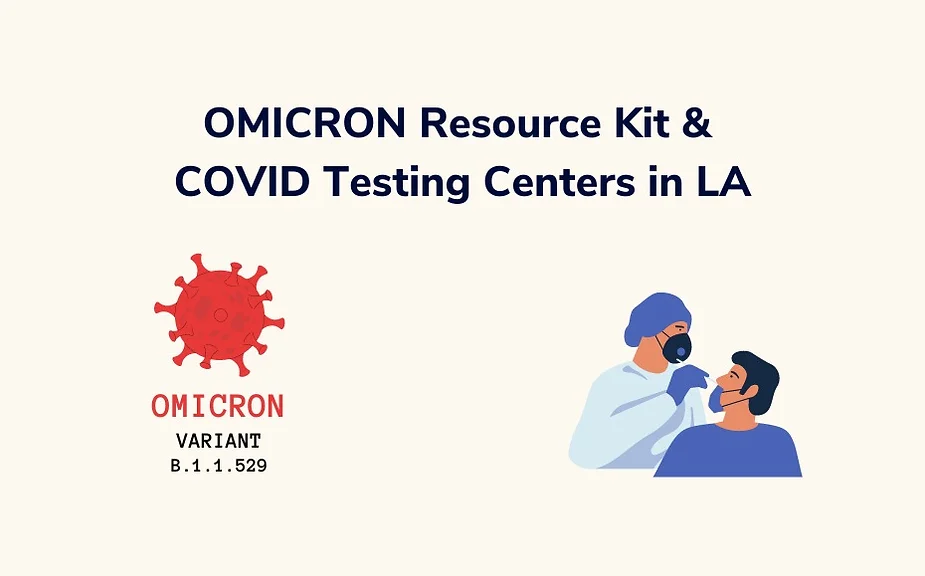- Hello • February 8, 2023
Los Angeles Omicron Resource Kit & List of COVID-19 Testing Centers

COVID-19 cases in Los Angeles have spiked, due to the Omicron variant. At the time of writing, 21 deaths and over 10,000 cases were reported in Los Angeles County alone. This was a staggering 15% increase from the count on December 23. Public Health Director Barbara Ferrer projects that the daily case count could reach as high as 20,000, the way things are trending.
In response to these trends, Los Angeles County is expanding access to free, confidential COVID testing. In this article, we will go over where and how you can get free testing in the Los Angeles area.
COVID-19 testing centers in Los Angeles:
1. Union Station (East Side) Testing Site – Walk-up only, no appointment required
City of Los Angeles
811 N. Vignes Street
Los Angeles
2. Axis Clinical Trials 1636 – Drive-up only, by appointment
Axis Clinical Trials
1636 Wilshire Boulevard
Los Angeles
3. Mexican Consulate – Walk-up only, no appointment required for COVID/Omicron testing
City of Los Angeles
2401 W 6th St
Los Angeles
4. Carbon Health – Echo Park – Walk-up only, appointment required
City of Los Angeles
2110 Sunset Blvd., Suite M, Suite M
Los Angeles
5. Lincoln Park – Walk-up only, no appointment required for COVID testing
City of Los Angeles
3501 Valley Blvd
Los Angeles
6. Anderson Munger YMCA – Pop-up testing site, walk-up only, no appointment required
County of Los Angeles
4301 West 3rd Street
Los Angeles
7. Poinsettia Recreation Center – Front Lawn – Pop-up site, walk-up only, appointment required for COVID Testing
County of Los Angeles
This is a pop-up testing site that travels to different communities.
7341 Willoughby Ave
Los Angeles
8. Via Care Community Health Center – Atlantic Blvd – Drive-in only, no appointment required
Via Care
507 S. Atlantic Blvd.
Los Angeles
9. CVS – Los Angeles – Drive-up only, appointment required for COVID/Omicron testing
CVS
5176 East Whittier Boulevard
Los Angeles
10. Hobart Elementary – KTPU Holiday Vaccination Fair – Pop-up site, walk-up only, appointment only
County of Los Angeles
980 S. Hobart Blvd.
Los Angeles
Home testing options:
If you cannot reach any of the listed COVID testing centers in LA, you can avail of the newly relaunched Holiday Home Test Collection Program. County residents who are symptomatic or believe they were exposed can order a free home testing kit from Fulgent Genetics.
Users must sign up to the Picture by Fulgent Genetics website to have their kits shipped to their address (not a P.O. Box), via FedEx. On the same day they receive the COVID testing kit, users should take their nasal samples and mail them back. You can do this either via a scheduled one-time Fed-Ex pick up, or drop box. Results will be available 48 hours after the sample reaches the lab.
COVID-19 vaccine centers in Los Angeles:
Even with regular testing, you still want extra protection from the virus. Luckily, California provides free vaccinations for citizens aged 5 and older. While this can vary, you also do not need an appointment for many vaccination centers. For a complete list of LA vaccination centers, you can refer to this official site.
Symptoms of the new COVID Variant “Omicron”
While the virus is still being studied closely, there are a couple recurring symptoms of the Omicron variant that are worth noting. Across many cases, “common-cold” like symptoms along with fatigue are the frequently-found. Notably, classic COVID-19 symptoms like loss of taste or tremendous shortness of breath were not as common. Newer symptoms such as vomiting and loss of appetite further distinguish the Omicron strain.
Predictably, case severity frequently hinged on vaccination status. For fully-vaccinated individuals with their booster shots, symptoms were mild. “Lots of sore throat (…) some fatigue, maybe some muscle pain. No difficulty of breathing, No shortness of breath. Mostly fine” specified Craig Spencer, Director of Global Health in Emergency Medicine at Columbia Medicine.
Patients fully vaccinated with Moderna/Pfizer but not boosted experienced similar but slightly stronger symptoms. Unboosted J&J patients “felt terrible” with fever, fatigue, coughing, and shortness of breath, but they didn’t need hospitalization or oxygen. Only unvaccinated patients displayed profound shortness of breath, as “they needed oxygen just to walk regularly.”
Frequently asked questions on OMICRON variant:
How severe is Omicron?
Currently, we cannot pinpoint how dangerous this strain really is. While a couple key patterns have been recognized, symptoms of the Omicron variant are inconsistent. Reinfections, breakthrough infections in the vaccinated, and deadlier cases are a possibility, but the data is too limited and it is far too early to make any strong conclusions.
Does vaccination work against Omicron?
As mentioned earlier, Omicron cases are milder for vaccinated individuals compared to previous strains. While a breakthrough case is possible, early signs are encouraging.
What can I do to prevent Omicron?
So far, pre-existing COVID-19 measures have still been shown to be effective. Along with vaccination, wearing a mask in high-density public settings is still strongly recommended by the CDC. COVID testing before going to populous gatherings or travel is another excellent preventative measure. Provided that one remains vigilant, they can protect themselves from Omicron to the best of their abilities.













